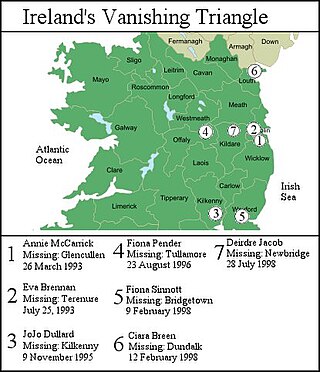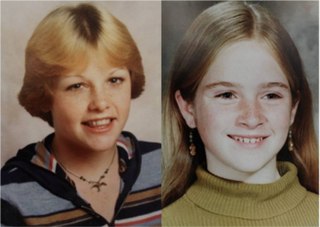
Laci Denise Peterson was an American woman murdered by her husband, Scott Lee Peterson, while eight months pregnant with their first child. Laci disappeared on December 24, 2002, from the couple's home in Modesto, California, after which Scott reported her missing. The remains of her and her unborn son, whom the couple had planned to name Conner, were discovered in April 2003 on the shores of San Francisco Bay. Subsequently, Scott was arrested and charged with two counts of murder. In November 2004, he was found guilty of the first-degree murder of Laci and the second-degree murder of the infant.
In forensic science, Locard's principle holds that the perpetrator of a crime will bring something into the crime scene and leave with something from it, and that both can be used as forensic evidence. Dr. Edmond Locard (1877–1966) was a pioneer in forensic science who became known as the Sherlock Holmes of Lyon, France. He formulated the basic principle of forensic science as: "Every contact leaves a trace". It is generally understood as "with contact between two items, there will be an exchange." Paul L. Kirk expressed the principle as follows:
Wherever he steps, whatever he touches, whatever he leaves, even unconsciously, will serve as a silent witness against him. Not only his fingerprints or his footprints, but his hair, the fibres from his clothes, the glass he breaks, the tool mark he leaves, the paint he scratches, the blood or semen he deposits or collects. All of these and more, bear mute witness against him. This is evidence that does not forget. It is not confused by the excitement of the moment. It is not absent because human witnesses are. It is factual evidence. Physical evidence cannot be wrong, it cannot perjure itself, it cannot be wholly absent. Only human failure to find it, study and understand it, can diminish its value.

The Palace of Justice siege was a 1985 attack on the Supreme Court of Colombia, in which members of the leftist M-19 guerrilla group took over the Palace of Justice in Bogotá and held the Supreme Court hostage, intending to hold a trial against President Belisario Betancur. The guerrilla group called themselves the "Iván Marino Ospina Company" after an M-19 commander who had been killed by the Colombian military on 28 August 1985. Hours later, after a military raid, the incident had left almost half of the twenty-five Supreme Court Justices dead.

The attorney general of the Republic is the head of the Attorney General's Office(Fiscalía General de la República, FGR; prior to 2019, Procuraduría General de la República, PGR) and the Federal Public Ministry of the United Mexican States, an institution belonging to the Federal Government's constitutional autonomous organism that is responsible for the investigation and prosecution of federal crimes. The office is governed mainly by article 102 of the 1917 Constitution and the Organic Law of the Attorney General's Office.

Enriqueta Martí i Ripollés was a Spanish child serial killer, kidnapper, prostitute and procuress of children. She was called "The Vampire of carrer Ponent", "The Vampire of Barcelona" and "The Vampire of the Raval" in the press.

On 18 June 2001, 15-year-old English schoolgirl Danielle Sarah Jones disappeared from East Tilbury, Essex, England. There was a large and exhaustive search to find Jones' body and it was considered one of the biggest cases Essex Police had to deal with at the time. Despite the police's best efforts, her body was never found.

Madeleine Beth McCann is a British missing person who, at the age of 3, disappeared from her bed in a holiday apartment in Praia da Luz, Lagos, Portugal, on the evening of 3 May 2007. The Daily Telegraph described her disappearance as "the most heavily reported missing-person case in modern history". Madeleine's whereabouts remain unknown, although German prosecutors believe she is dead.
Amarte así, also known as Frijolito, is a Spanish-language telenovela produced by the American-based television network Telemundo. It stars Litzy, Mauricio Ochmann, Roberto Mateos, Alejandro Felipe, and Carla Peterson. It was written by Enrique Torres, directed by Heriberto Lopez de Anda, Cristina Palacios, Hugo A. Moser; with Cristina Palacios as General Producer. The telenovela debuted it on April 5, 2005, at the 7 pm timeslot.
The murder of Phylicia Barnes is believed to have occurred in Baltimore, Maryland, United States, on December 28, 2010, in relation to a crime. Her body was recovered in the Susquehanna River on April 20, 2011, following a series of searches and national media coverage from various outlets, including The Today Show. The investigation into her death was ruled a homicide. About a year later, on April 25, 2012, her half-sister's ex-boyfriend, Michael Johnson, was arrested and charged with her murder. At the time, police declined to provide any details as to how the murder occurred, how they identified him as a suspect, or a motive in the case. Johnson was convicted on February 6, 2013, of second-degree murder. However, the conviction was overturned when the trial judge granted the defense's motion for a new trial. Upon commencement of the second trial, all charges against Johnson were dropped on January 20, 2015.

Ireland's Vanishing Triangle is a term commonly used in the Irish media when referring to a number of high-profile disappearances of Irish women from the late-1980s to the late-1990s. Several other women were also murdered within the triangle and their cases remain unsolved as well. All of the cases appeared to share some common characteristics. The women's ages range from their late-teens to late-30s, they disappeared inexplicably and suddenly, and no substantial clues or evidence of their fate has ever been found despite large scale searches and campaigns by the Gardaí to find them. Gardaí believe their remains are likely to be buried in remote fields, bogs and forests. The triangle is in the eastern part of the island, roughly the boundaries of Leinster, in an 80-mile area outside Dublin.

On September 26, 2014, forty-three male students disappeared from the Ayotzinapa Rural Teachers' College after being forcibly abducted in Iguala, Guerrero, Mexico. They were allegedly taken into custody by local police officers from Iguala and Cocula in collusion with organized crime. The mass kidnapping has caused continued international protests and social unrest, leading to the resignation of Guerrero Governor Ángel Aguirre Rivero in the face of statewide protests on October 23, 2014.

The murders of Kerry Ann Graham and Francine Marie Trimble are currently unsolved crimes that occurred in December 1978, when both girls—aged 15 and 14 respectively—disappeared after leaving their homes in Forestville, California, to visit a shopping mall in Santa Rosa. Their remains were discovered in July 1979 approximately 80 mi (130 km) north of Forestville, concealed within duct-taped garbage bags and buried within an embankment of a heavily overgrown woodland area located beside a remote section of Highway 20, 12 mi (19 km) from the city of Willits.

Federico Tobares, an Argentine chef working in Mexico, disappeared in 2013 in a suspected organized crime killing. Tobares was last seen around midday on 5 June 2013 in Guadalajara, Jalisco, Mexico, after driving from Puerto Vallarta in the same state. He was last heard from half an hour later when he phoned a friend. His friend told investigators that Tobares had told her that he was delivering a car for his boss and was being guided, but was scared and did not know where he was. The car was found two weeks later in nearby Michoacán. Gerardo González Valencia, the owner of the restaurants where Tobares had been working, was later imprisoned for money laundering, and is accused of drug trafficking as a leader of the Jalisco New Generation Cartel. No trace of Tobares has ever been found.
The Aguilar de Campoo case refers to the disappearance of Virginia Guerrero Espejo and Manuela Torres Bouggefa, two teenaged girls, on April 23, 1992. Guerrero (14) and Torres (13) were last seen hitchhiking from the municipality of Reinosa, Cantabria, to their hometown of Aguilar de Campoo, Palencia. Their disappearance remains unsolved.

Miroslava Breach Velducea was a Mexican investigative journalist for La Jornada and Norte de Juárez in Chihuahua City, Mexico known for her reportage of human rights violations, drug trafficking, and government corruption. She was murdered on 23 March 2017 as she was leaving her home. She was one of six journalists killed in Mexico in 2017.
Óscar García Guzmán, known as The Monster of Toluca, is a Mexican serial killer. He was first identified as a suspect in the disappearance of a fellow Technological University of Mexico (UNITEC) student on October 30, 2019, when, after searching his home in Villa Santin, Toluca, State of Mexico, police officers found the strangled bodies of three women, two of which were buried in his backyard and the other was hidden in his bathroom. Guzmán fled from the police and boasted that he would continue to kill women unless his pets' safety was guaranteed, though he was arrested in Mexico City on December 6, 2019, by the Attorney General's Office. After his capture, he admitted to the killing of not only the three women found in his home, but also to the murders of a girl and her father in Otzolotepec in 2012 and to the murder of his own father in 2006, when he was just 16 years old; the prosecution has confirmed these three further confessions. Guzmán was sentenced by the Attorney General of the State of Mexico to prison. He had previously been sentenced to 12 years in September 2021 for the crime of rape, however, after further investigation, he was sentenced to an additional 17 years for his responsibility in the disappearance of a woman. Finally, on March 31, 2022, he received another sentence for 62 more years, after being convicted of the murder of a 23-year-old woman. The total sum of his 3 first convictions gave him a total of 91 years in prison, however, after admitting to more murders during a call to his mother, he was charged with three additional sentences, in total, he has been condemned to 217 years and six months in jail.

Crime Diaries: The Search is a Mexican streaming television series produced by Dynamo for Netflix. It stars Regina Blandón, Darío Yazbek Bernal and Verónica Bravo, and the story is based on the case of the disappearance and death of 4-year-old girl Paulette Gebara Farah. All 6 episodes of the season became available for streaming on Netflix on 12 June 2020. The series received criticism for its light comedy tone, the poor performance of Yazbek and for omitting all mentions regarding both Paulette's parents' roles in the events.

Jessie Earl was a 22-year-old student who disappeared from Eastbourne, England in May 1980. It was not until 1989 that her remains were discovered in thick undergrowth on Beachy Head, where she would regularly take walks. The inquest into her death was criticised and attracted considerable controversy in the long term after it was concluded that there was "insufficient evidence" to determine whether she had been murdered, despite the fact that she had been found with her bra tied around her wrists and without any of her other clothes or belongings. Her parents insisted she must have been murdered, but the inquest into her death recorded an open verdict, leading to the key forensic evidence being destroyed in 1997 since the case had not been classed as murder. Despite this, in 2000 Sussex Police opened a murder investigation after further forensic, scene, witness and pathology inquiries, saying that they believed she was murdered.
Facundo Astudillo Castro was an Argentine citizen who went missing after being stopped by the police during the COVID-19 pandemic strict lockdowns in Argentina. He was hitchhiking from Pedro Luro to Bahía Blanca, when in the town entrance of Mayor Buratovich was stopped in a police checkpoint of circulation permits. His last known image, taken the day of disappearance, depicts him being held by the police for violating the lockdown, with his hands against the police vehicle number RO 23360. It was cataloged by the victim family as a Forced disappearance in hands of the Buenos Aires Provincial Police. This theory was also followed by human rights activist Estela de Carlotto. Nora Cortiñas, another known activist in Argentina, demanded the resignation of Sergio Berni, the Buenos Aires Province Minister of Security. The minister considered this an irresponsible request.

On 9 April, 2022, 18 year-old law student Debanhi Susana EscobarBazaldúa disappeared from Monterrey, Nuevo Leon, Mexico. Thirteen days later on April 22, her remains were found in a cistern, in a motel in General Escobedo, a municipality of Monterrey metropolitan area. The body had visible signs of violence.















